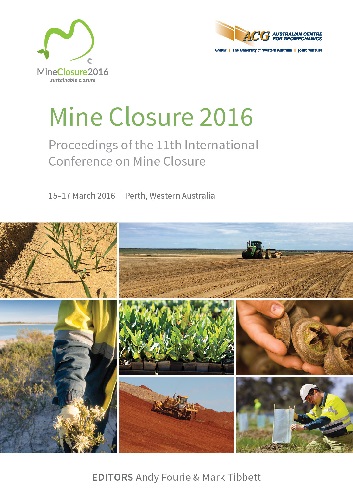Abandoned mines — environmental, social and economic challenges

|
Authors: Bennett, K |
DOI https://doi.org/10.36487/ACG_rep/1608_16_Bennett
Cite As:
Bennett, K 2016, 'Abandoned mines — environmental, social and economic challenges', in AB Fourie & M Tibbett (eds), Mine Closure 2016: Proceedings of the 11th International Conference on Mine Closure, Australian Centre for Geomechanics, Perth, pp. 241-252, https://doi.org/10.36487/ACG_rep/1608_16_Bennett
Abstract:
The environmental, social and economic problems associated with abandoned mine sites are serious and global. Abandoned mines may pose unique and complex challenges, often leaving negative impacts such as: safety and health hazards for people and animals, neglected mining heritage and other assets, in addition to economically-depressed communities. Acid and metalliferous drainage (AMD), also known as acid mine drainage, is one of the negative environmental impacts on water quality that can result in a subsequent loss of biodiversity. AMD impacts can occur from underground workings, open pit mine faces, waste rock landforms, and tailings storage areas that were left exposed to the elements or inadequately rehabilitated, resulting in the contamination of water with dissolved metals and acidity. Social and economic impacts on countries and individual communities can be due to issues such as: a loss of the productive land, loss or degradation of groundwater, pollution of surface water by sediments or salts, changes in river regimes, air pollution from dust or toxic gases or risk of falls into shafts or open pits. Resources for cleaning up abandoned mines are very limited in most jurisdictions. A strong policy framework is required and, in order to be effective, primary policy elements must be embedded in the legislative framework. This paper explores the international dialogue that has taken place on abandoned mines, our improved understanding of legal liability, funding remediation and rehabilitation and the strategies that are in place to minimise the likelihood of more mines being abandoned.
References:
AusIMM (Australasian Institute of Mining and Metallurgy, The) 2013, Abandoned Mines Policy Statement, June 2013.
Bell, LC 2003, Proceedings of the Workshop on management and remediation of abandoned mines, (ACMER) Australian Centre for Mine Environmental Research in association with the Minerals Council of Australia, Brisbane.
BLM (Bureau of Land Management) 2007, Abandoned Mine Lands: A Decade of Progress Reclaiming Hardrock Mines, Forest Service Publication (FS-891), September 2007.
Castrilli, J 2007, Wanted: A Legal Regime to Clean Up Orphaned/Abandoned Mines in Canada.
DMP (Department of Mines and Petroleum) 2015, Abandoned Mines Policy, Government of Western Australia, Draft for Consultation, July 2015.
Johnston, D, Potter, H, Jones, C, Rolley, S, Watson, I & Pritchard, J 2008, Abandoned mines and the Water Environment: Science project SC030136-41, Environment Agency, the Scottish Environment Protection Agency (SEPA), the Coal Authority (The Environment Agency et al.), Rio House, Waterside Drive, Aztec West, Almondsbury, Bristol.
MCMPR & MCA (Minerals Council on Mineral and Petroleum Resources and Minerals Council of Australia) 2010, Strategic Framework for Managing Abandoned Mines.
Mudd, GM 2009, The Sustainability of Mining in Australia: Key Production Trends and Their Environmental Implications for the Future, Department of Civil Engineering, Monash University and Mineral Policy Institute, Melbourne, VIC, p. 277.
Mudd, GM 2013, ‘Australia’s Mining Legacies’, in Arena Magazine, (the Australian Magazine of Left Political, Social and Cultural Commentary).
Pearman, G 2009, 101 Things to do with a Hole in the Ground, Post Mining Alliance, Cornwell UK.
Pepper, M, Roche, C & Mudd, G, 2012, ‘Mining Legacies – Understanding Life-of-Mine Across Time and Space’, in proceedings LifeofMine 2014 Conference, The Australian Institute of Mining and Metallurgy, Brisbane, p449–465.
Pepper, M, Roche, C & Mudd, G 2014, ‘Australia’s mining legacy challenge’, in proceedings Life-of-Mine 2014 Conference, The Australian Institute of Mining and Metallurgy, Brisbane.
Sphiwe, EM & Francis, AD 2015, ‘A review of problems and solutions of abandoned mines in South Africa’, International Journal of Mining, Reclamation and Environment.
Stewart, G 2015, ‘British Columbia’s Crown Contaminated Sites Program – a Ten Year Review’, in AB Fourie & M Tibbett (eds), Proceedings of the 10th International Conference on Mine Closure, InfoMine.
Tremblay, G & Hogan, C 2012, Experience of Canadian Partnership Programs – Mine Environment Neutral Drainage and National Orphaned /Abandoned Mines Initiative, in Proceedings Life-of-Mine 2012, p11-12, Brisbane 10-12 July 2012, (The Australian Institute of Mining and Metallurgy, Melbourne)
UNEP (United Nations Environment Programme) 2000, Mining and Sustainable Development II - Challenges and Perspectives, Division of Technology, Industry and Economics, ISSN 0378-9993.
UNEP & Cochilco (United Nations Environment Programme & Chilean Copper Commission) 2001, Abandoned Mines - Problems, Issues and Policy Challenges for Decision Makers: Summary Workshop Report, UNEP & Cochilco, Chile.
Unger, CJ 2009, Leading practice abandoned mine rehabilitation and post-mining land use, Churchill Fellowship report, p. 76,
Unger, C 2012, Value Proposition for National Abandoned/Legacy Mine Hub at CMLR/SMI/UQ, (Centre for Mined Land Rehabilitation (CMLR), Brisbane.
Unger, C, Lechner, A, Glenn, V, Edraki, M & Mulligan, D 2012, ‘Mapping and Prioritising Rehabilitation of Abandoned Mines in Australia’, in Proceedings Life-of-Mine 2012, The Australian Institute of Mining and Metallurgy, Brisbane, pp. 259–266.
Unger, CJ, Lechner, AM, Walton, A, Glenn, V, Edraki, M & Mulligan, DR 2014, ‘Maturity of Jurisdictional Abandoned Mine Programs in Australia based on Web-Accessible Information’, in Proceedings Life-of-Mine 2014, The Australian Institute of Mining and Metallurgy, Brisbane.
Whitbread-Abrutat, P 2008, Mining legacy survey, informing the background paper, Post-Mining Alliance, Eden Project, UK.
Worrall, R, Neil, D, Brereton, D & Mulligan, DR 2009, ‘Towards a sustainability criteria and indicators framework for legacy mine land’, Journal of Cleaner Production, vol. 17, pp. 1426–1434.
© Copyright 2025, Australian Centre for Geomechanics (ACG), The University of Western Australia. All rights reserved.
View copyright/legal information
Please direct any queries or error reports to repository-acg@uwa.edu.au
View copyright/legal information
Please direct any queries or error reports to repository-acg@uwa.edu.au